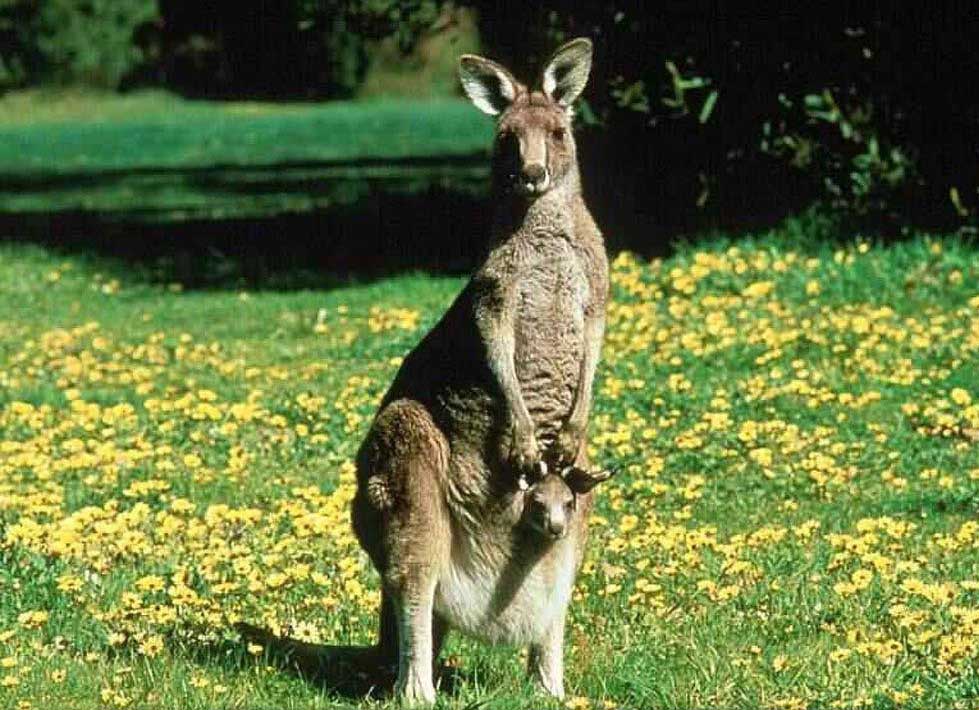Login form
Kangaroo
 Kangaroo, common name for a group of mammals found in Australia and neighboring islands. Kangaroos are marsupials, a type of mammal that gives birth to undeveloped young. In kangaroos and many other marsupials, the young are carried and nurtured in a special pouch on the mother's body.
Kangaroo, common name for a group of mammals found in Australia and neighboring islands. Kangaroos are marsupials, a type of mammal that gives birth to undeveloped young. In kangaroos and many other marsupials, the young are carried and nurtured in a special pouch on the mother's body.
More than 50 different kinds of animals are grouped together in two kangaroo families. The large kangaroos include red kangaroos and gray kangaroos, wallabies, pademelons, and quokka; they belong in the family Macropodidae. The other family, Potoroidae, is made up of assorted smaller species, such as various rat-kangaroos, bettongs, and potoroos.
The largest kangaroos are the gray kangaroo and red kangaroo, which can stand up to 2 m (6.5 ft) tall and weigh up to 85 kg (187 lb). The smallest are the musky rat-kangaroos, ratlike animals measuring about 30 cm (12 in), not including the tail.
 Kangaroos are found only in mainland Australia and New Guinea and on some of their offshore islands, such as Tasmania. A few species have been introduced to other countries, such as tammars in New Zealand and a rock wallaby in Hawaii. Kangaroos inhabit every imaginable type of habitat throughout Australia and New Guinea. Red kangaroos and gray kangaroos are found in grasslands, savannas, and open woodlands. Rock wallabies live on nearly vertical rock walls in the southern desert. Bettongs inhabit burrows in arid scrubland. As their name implies, tree kangaroos are found high in the rain forest canopy, while rat-kangaroos scamper nimbly through the dense, wet understory below. Red-necked wallabies live in many habitats, including the frigid peaks of Tasmania's mountains, and the endangered quokka's last refuge is just two windblown islands off the southwestern Australia coast. Several species of kangaroos are so adaptable that they are common inhabitants of public parkland, suburban gardens, and even golf courses.
Kangaroos are found only in mainland Australia and New Guinea and on some of their offshore islands, such as Tasmania. A few species have been introduced to other countries, such as tammars in New Zealand and a rock wallaby in Hawaii. Kangaroos inhabit every imaginable type of habitat throughout Australia and New Guinea. Red kangaroos and gray kangaroos are found in grasslands, savannas, and open woodlands. Rock wallabies live on nearly vertical rock walls in the southern desert. Bettongs inhabit burrows in arid scrubland. As their name implies, tree kangaroos are found high in the rain forest canopy, while rat-kangaroos scamper nimbly through the dense, wet understory below. Red-necked wallabies live in many habitats, including the frigid peaks of Tasmania's mountains, and the endangered quokka's last refuge is just two windblown islands off the southwestern Australia coast. Several species of kangaroos are so adaptable that they are common inhabitants of public parkland, suburban gardens, and even golf courses.
Fossil evidence shows that the first kangaroos appeared in Australia about 15 million years ago, during the Miocene Epoch. As a result of climate changes about 8 million years ago, Australia's rain forests gave way to open woodlands and savanna, and kangaroos evolved into many of the forms we know today. The now extinct giant kangaroos stood up to 3 m (10 ft) high and weighed 200 kg (440 lb).
Physical Characteristics
Most kangaroo species have large ears and relatively small heads. Their small front feet have five digits of unequal length, while the back feet typically have four digits. One of the toes on each hind foot has a sharp claw used in defense. Many species are drably colored to closely match their surroundings, helping them to hide from predators. Males of the larger kangaroo species are noticeably bigger in size than the females, a trait known as sexual dimorphism.
A physical feature that distinguishes kangaroos from other marsu
pials is the adaptation of the hind legs and tail for hopping. In red kangaroos, for example, the hind legs are very large—roughly ten times the size of the small front limbs. When moving slowly, kangaroos use all four legs. When they need to move fast, they rise up on their muscular hind legs and start hopping.
The leaps of some kangaroos are legendary. Red kangaroos moving at top speeds ca n cover 5 m (16 ft) or more in a single bound. They are able to reach speeds of more than 50 km/h (31 mph) for short periods. The kangaroo's heavy, muscular tail is also important for locomotion. It serves as a counterbalance and a rudder during hopping, and provides support when the animal sits.
n cover 5 m (16 ft) or more in a single bound. They are able to reach speeds of more than 50 km/h (31 mph) for short periods. The kangaroo's heavy, muscular tail is also important for locomotion. It serves as a counterbalance and a rudder during hopping, and provides support when the animal sits.
The only member of the kangaroo family that does not hop is the musky rat-kangaroo. Scientists have tried to learn why hopping is so widespread among kangaroos but is so rare in other mammals. Studies have shown that hopping is energy efficient for kangaroos, partly because of springlike tendons in their legs. The energy required to start hopping is quite high, but very little extra energy is needed to hop faster and faster. In contrast, mammals that run on all fours require increasing amounts of energy as speed increases.

